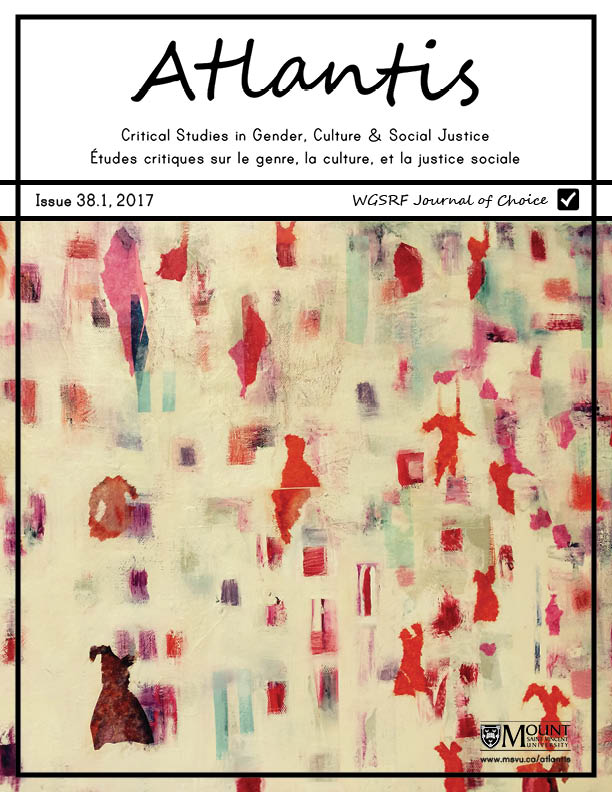Things That Make You Go Hmmm: Unmaking of the Racialized Self in a Graduate School Classroom
Keywords:
Intersectionality, Identity, RaceAbstract
Using storytelling methodologies and counter storytelling I use three situations within my life as a racialized woman to exemplify the practices and symptoms of institutionalized intersectionality. Using my stories and the many useful critiques of intersectionality, I discuss how institutionalized intersectionality is failing marginalized women because institutions are co opting “outsider” language and imposing it on bodies of their choosing.
Résumé À l’aide de la notion des contre-récits de la théorie critique de la race, j’utilise trois situations au sein de ma vie en tant que femme racialisée dans le monde universitaire pour illustrer les pratiques et les symptômes de l’intersectionnalité institutionnalisée. À l’aide de mes expériences et des nombreuses critiques utiles de l’intersectionnalité, je discute de la façon dont l’intersectionnalité institutionnalisée trahit les femmes marginalisées parce que les institutions cooptent le langage « marginal » et l’imposent aux organes de leur choix.References
Adichie, Chimamanda Ngozi. 2009. “The Danger of a Single Story” (video presentation).TEDGlobal. http://www.ted.com/talks/chimamanda_adichie_the danger_of_a_single_story.html.
Ahmed, Sara. 2012. On Being Included. Durham, NC: Duke University Press.
Brown, Wendy. 1997. “The Impossibility of Women's Studies.” differences: A Journal of Feminist Cultural Studies 9 (3): 79-101.
C+C Music Factory. 1991. “Things That Make You Go Hmm” (vocal performance). By Robert Clivillés and Freedom Williams. On Gonna Make You Sweat, Columbia. Released June 23, 1991.
Crenshaw, Kimberlé. 1989. “Demarginalizing the Intersection of Race and Sex: A Black Feminist Critique of Anti-Discrimination Doctrine, Feminist Theory, and Antiracist Politics.” University of Chicago Legal Forum 140: 139-67.
Crenshaw, Kimberlé. 1991. “Mapping the Margins: Intersectionality, Identity Politics, and Violence Against Women of Color.” Stanford Law Review 43 (6): 1241-99.
Crenshaw, Kimberlé. 2015. “Why Intersectionality Can’t Wait.” Washington Post, September 24. https://www.washingtonpost.com/news/in-theory/wp/2015/09/24/why-intersectionality-cant-wait/?postshare=7431457417542153&tid=ss_fb2.
Davies, Bronwyn, Jenny Browne, Susanne Gannon, Eileen Honan, Cath Laws, Babette Mueller-Rockstroh, and Eva Bendix Petersen. 2004. “The Ambivalent Practices of Reflexivity.” Qualitative Inquiry 10 (3): 360-89.
Delgado, Richard. 1989. “Storytelling for Oppositionists and Others: A Plea for Narrative.” Michigan Law Review 87 (8): 2411-41.
Henry, Frances, and Carol Tator. 2012. “Interviews with Racialized Faculty Members in Canadian Universities.” Canadian Ethnic Studies 44 (2): 75-99.
Hirschmann, Nancy J. 2012. “Disability as a New Frontier for Feminist Intersectionality Research.” Politics & Gender 8 (3): 396-405.
Hooks, Bell. 1992. Black Looks: Race and Representation. Boston: South End Press.
Matsuda, Mari J. 1991. “Beside My Sister, Facing the Enemy: Legal Theory Out of Coalition.” Stanford Law Review 43 (6): 1183-96.
Nash, Jennifer C. 2008. “Re-thinking Intersectionality.” Feminist Review 89: 1-15.
Nash, Jennifer C. 2014. “Institutionalizing the Margins.” Social Text 32 (1): 45-65.
Puar, Jasbir K. 2007. Terrorist Assemblages: Homonationalism in Queer Times. Durham, NC: Duke University Press.
Razack, Sherene. 1998. Looking White People in the Eye: Gender, Race, and Culture in Courtrooms and Classrooms. Toronto: University of Toronto Press.
Smith, Malinda. 2010. “Gender, Whiteness, and “Other Others” in the Academy.” In States of Race: Critical Race Feminism for the 21st Century, edited by Sherene Razack, Malinda Smith, and Sunera Thobani, 37-58. Toronto: Between the Lines.
Tuck, Eve. 2009. “Suspending Damage: A Letter to Communities.” Harvard Educational Review 79 (3): 409-28.
Tuck, Eve, & Yang, K. Wayne. 2012. “Decolonization is not a Metaphor.” Decolonization : Indigeneity, 1(1): 1-40.
Wiegman, Robyn. 2012. Object Lessons. Durham, NC: Duke University Press.
Williams, Patricia. 1992. The Alchemy of Race and Rights: Diary of a Law Professor. Boston: Harvard Press.
Downloads
Published
Issue
Section
License
Copyright (c) 2017 Atlantis: Critical Studies in Gender, Culture & Social Justice

This work is licensed under a Creative Commons Attribution 4.0 International License.
Authors who publish with this journal agree to the following terms:
1. Authors retain copyright and grant the journal right of first publication, with the work simultaneously licensed under a Creative Commons Attribution 4.0 International License that allows others to share the work with an acknowledgement of the work's authorship and initial publication in this journal.
2. Authors are aware that articles published in Atlantis are indexed and made available through various scholarly and professional search tools, including but not limited to Erudit.
3. Authors are able to enter into separate, additional contractual arrangements for the non-exclusive distribution of the journal's published version of the work (e.g., post it to an institutional repository or publish it in a book), with an acknowledgement of its initial publication in this journal.
4. Authors are permitted and encouraged to preprint their work, that is, post their work online (e.g., in institutional repositories or on their website) prior to and during the submission process. This can lead to productive exchanges, as well as earlier and greater citation of published work. Read more on preprints here.







